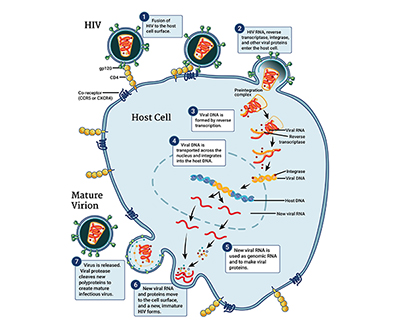
The HIV replication cycle.
Credit: NIAID
When HIV infects a cell, it inserts its genetic material into the host genome. The viral enzyme integrase plays a key role in this process, and drugs blocking its action are an important component of HIV therapy. However, HIV and other retroviruses retain some insertion activity even in the absence of integrase. Understanding how this happens can help inform and improve HIV treatment strategies.
To understand how viral DNA can be incorporated into the host genome in the absence of integrase, the Levin Lab examined Tf1, a long terminal repeat (LTR) retrotransposon in the yeast Schizosaccharomyces pombe. LTR retrotransposons are segments of genetic material closely related to retroviruses that also rely on integrase to move within the genome.
The scientists characterized the integrase-independent mechanism of Tf1, finding that integrase-independent insertions occur at specific DNA sequences and at positions that differ substantially from those of insertions coordinated by integrase. The team found that integrase-independent insertions involve host enzymes that bind to the ends of the retrotransposon. Unexpectedly, they found that Tf1 can switch from the integrase-dependent mechanism of insertion to the integrase-independent one depending on culture conditions.
Further research is needed to determine whether HIV can use a similar method of integrase-independent insertion under certain conditions, such as during the use of integrase-blocking drugs.
Learn more about the Cell Regulation and Development Group: https://www.nichd.nih.gov/about/org/dir/affinity-groups/CRD
 BACK TO TOP
BACK TO TOP